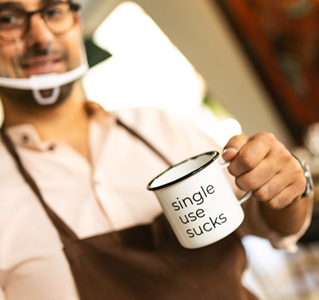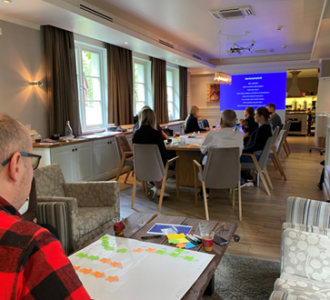The Mission Zero Foodprint project, run by Forum Virium Helsinki and Laurea UAS (2019-2021), promotes carbon neutrality of restaurants by measuring and managing carbon footprint and making the change visible for consumers. During the project, co-creation and pilots were carried out in collaboration with restaurants and other stakeholders in the Uusimaa region in Southern Finland. The aim was to find suitable digital solutions and operating models, especially for small and medium-sized restaurants. When co-creating with restaurants, the specific nature of the restaurant business needs to be considered, especially during COVID-19. to support their work becoming climate-friendly.
Co-creation towards carbon-wise restaurants
 Figure 1. Luca Balac, one of the owners of partner restaurant Nolla. Photo: Antero Semi.
Figure 1. Luca Balac, one of the owners of partner restaurant Nolla. Photo: Antero Semi.
Co-creation can be defined as a process in which end-users are engaged to create effective solutions to problems together with experts and designers (Cottam & Leadbeater 2008). It allows for solving large, systems-level issues of which climate change is a good example (Mazzucato 2018). Mission Zero Foodprint engaged restaurants to decrease their carbon footprint to assist in reaching the national climate targets of becoming carbon neutral by 2035 (Finnish Government 2019). Restaurants have a key role in changing consumer behaviors towards carbon-wise diets (Saarinen et al. 2019). Furthermore, digital tools and data can also offer competitive advantages and support consumers’ informed choices.
The co-creation and piloting process aimed to create an operating model for a carbon-wise activity for restaurants. The Mission Zero Foodprint co-creation started with six workshops that were hosted in 2020, engaging about 150 participants. Most of the workshops were organized virtually due to the COVID-19 situation. Workshop design included ideation, prioritization, conceptualizing, creating customer journeys, and creating customer insights for digital tools. From the co-creation workshop results, the operating model for restaurants was developed and then piloted.
 Figure 2. Workshop for pilot restaurants at the end of the project. Photo: Emilia Risu.
Figure 2. Workshop for pilot restaurants at the end of the project. Photo: Emilia Risu.
A Living Labs approach was used while the framework for carbon-wise activities was piloted in 10 partner restaurants. LiIving Labs are real-life development environments that operate by the principles of user-centricity, open innovation and by creating ecosystems between different societal actors (Heikkanen & Österberg 2012; Nyström & Leminen 2011; Schuurman & Tõnurist 2017). This pilot phase started with a boot camp and was orchestrated through the tool Howspace, which provided a platform for contact-free communications and collecting piloting data. The restaurants chose ideas to prototype in their environment so that the operating model would be suitable for their business model. The impact of the operating model activities was measured using the digital tools that were part of the piloting phase.
Challenges
The ideas gathered from the co-creation workshops were very generic, so iteration was needed before the piloting phase. Iteration was achieved through benchmarking with restaurants that are pioneers in sustainability. Another challenge was to get the core target group, small and medium-sized restaurants, to participate in the workshops because entrepreneurs are often caught up in running the daily restaurant operations.
During the piloting phase, the practices for informing the pilot restaurants and means to follow up were essential because, in this case, the living lab approach was implemented in the piloting restaurants, and it was not possible to monitor the living lab environment closely. Due to COVID19, even visiting the restaurants was restricted.
Successes
The restaurant industry is interested in reducing its carbon footprint to respond to customer needs for sustainable options. Because workshops were organized virtually, many ideas were collected, and senior experts were engaged nationally.
The co-creation process achieved successful dialogues between different food and restaurant industry actors. Participants included governmental agencies, educational institutions, large food & restaurant corporations and small and medium-sized restaurants, restaurant management systems, other carbon footprint-related projects, and pioneers in the food industry.
During the piloting, the digital solutions providers for measuring carbon footprint and food waste gained relevant understanding to develop their tools better to suit the diverse restaurant businesses.
Lessons learned
When restaurants that operate as living lab environments are situated separately, and when it is not possible to meet in person, there is a need to create a transparent, structured process for the orchestration of the pilots. A platform is needed, and engagement through regular virtual gatherings and keeping in touch individually. Organizing a possibility for reflection, peer support, and proactive offering of help to the restaurants was critical in keeping the pilot restaurants engaged.
The wide variety of ideas collected and developed in Mission Zero Foodprint’s co-creation process resulted from purposeful collaboration with the restaurant industry. The process allowed for a deep understanding of real challenges restaurants face when attempting to reduce their carbon footprints, and developing viable, practical solutions. The final result of the process was an Operating Model for Carbon-wise Activities for Restaurants published in the Workbook Restaurants and Carbon Footprint. The Operating Model illustrates how a restaurant can plan their daily activities to become more carbon-wise.
 Figure 3. Operating model for Carbon-wise Activities for Restaurants. Photo: Mission Zero Foodprint project.
Figure 3. Operating model for Carbon-wise Activities for Restaurants. Photo: Mission Zero Foodprint project.
Restaurants and Carbon Footprint – Mission Zero Foodprint Workbook can be downloaded here: https://www.theseus.fi/handle/10024/753021
References:
- Cottam, H. & Leadbeater, C. 2004. HEALTH. Co-creating Services. The Design Council. Viitattu 2.2.2022. https://www.designcouncil.org.uk/sites/default/files/asset/document/red-paper-health.pdf
- Finnish Government. 2019. Inclusive and competent Finland – a socially, economically and ecologically sustainable society. Programme of Prime Minister Sanna Marin’s Government 2019. Viitattu 2.2.2022. https://valtioneuvosto.fi/en/marin/government-programme
- Heikkanen, S., Österberg, M. 2012. Living Lab ammattikorkeakoulussa. Vantaa. Multiprint. Referred 8.8.2022
- Leminen, S., Westerlund, M. & Nyström, A-G. 2012. Living Labs as Open-Innovation Networks. Technology Innovation Management Review, 2(9), 6-11. https://doi.org/10.22215/timreview/602.
- Mazzucato, M. 2018. Mission-oriented research & innovation in the European Union. Luxembourg: Publications Office.
- Saarinen M., Kaljonen, M., Niemi, J., Antikainen, R., Hakala, K., Hartikainen, H., Heikkinen, J., Joensuu, K., Lehtonen, H.,Mattila, T., Nisonen, S., Ketoja, E., Knuuttila, M., Regina, K., Rikkonen, P., Seppälä, J. & Varho, V. 2019. Ruokavalion muutosta tukevat politiikkayhdistelmät, RuokaMinimi-hankkeen loppuraportti. Valtioneuvoston selvitys- ja tutkimustoiminnan julkaisusarja 2019:47. http://urn.fi/URN:ISBN:978-952-287-773-4
- Schuurman, D. & Tõnurist, P. 2017. Innovation in the Public Sector: Exploring the Characteristics and Potential of Living Labs and Innovation Labs. Technology Innovation Management Review, 7(1), 7-14. http://DOI:10.22215/timreview/1045